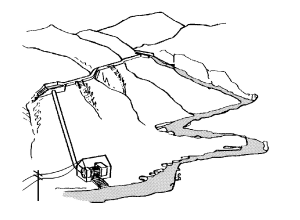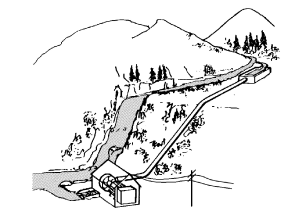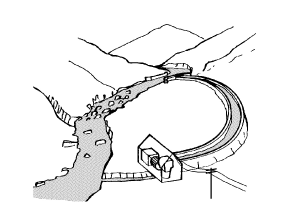Hydro is “clean”
Hydro electricity is the cleanest form of energy available. It can and must play a significant role in addressing concerns about climate change and air quality.
Conventional means of generating electricity are dirty and unsustainable. Coal contributes significantly to the summer smog, which leads to thousands of premature deaths and tens of thousands of hospital visits every year. Coal power, oil and gas generation are major contributors to global warming.
By contrast, waterpower, produces no greenhouse gas emissions.
Small run-of-the-river micro hydro generators, need minimal construction and don’t disrupt the flow of the river downstream, significantly lessening the impact on the environment. And there are many potential sites for run-of-the-river generation including those with existing structures.
The Basics of Hydro
Hydropower uses turbines to convert the energy of falling water into electricity. Micro-hydro systems usually generate less than 100 kW and are “run of the river” operations that don’t involve large dams or water storage reservoirs, so they generally create very little impact on the local ecosystem.
Hydro Facts
Greater awareness of the potential damage to the planet from global warming has lead governments to take measures to mitigate the impacts of human activity on the climate. With little or no CO2 and other greenhouse gas emissions and high energy payback, hydropower supports clean development and is recognized as being fully renewable and sustainable.
- Hydropower is the world’s leading renewable energy resource and the oldest method of harnessing clean power – the first waterwheels were used over 2,000 years ago
- It currently produces around 17% of the world’s electricity and 90% of the world’s renewable power
- Twenty-five countries depend on hydropower for 90% of their electricity
- Less than one third of the world’s practical hydro capacity has been developed
- Hydropower beats all other electricity generating technologies with a pay-back ratio of 300 (energy produced/energy to produce) – this is ten times more than oil-fired power stations.
- There are no direct CO 2 emissions from hydro projects.
- Small hydro schemes have minimum visual impact on their surrounding environment.
- Hydropower, after 150 years as an electricity generating source, is still one of the most inexpensive ways to generate power
- Most large hydro stations have dams but thousands of small hydro stations don’t – they are ‘run-of-river’ schemes and make a minimal impact on the environment
- Hydro is the only renewable technology that can be used to store large quantities of energy in a clean environmentally-friendly way. This is done by reservoir storage and pumped storage schemes.
- Hydro installations can have a useful life of over 100 years – many such plants are in existence worldwide
- A modern hydro turbine generator can convert over 90% of the energy in the available water into electricity. This is more efficient than any other form of generation.
State of the Industry
Waterpower has been used for centuries to grind grains and, more recently, to generate electricity. Currently it is a major source of energy in Ontario, but much of this comes from big projects.
That still leaves thousands of megawatts of untapped potential, however: there are thousands of rivers and streams in the province that could be used to generate electricity.
Is a Micro-Hydro System Right for Me?
Clearly, the first requirement is to have a suitable stream or river on your property. The amount of energy you can capture depends on the flow rate (how much water flows per second) and the head (the vertical distance it falls). You’ll need at least a year’s worth of data on water flow to decide if it’s worth installing a system at a particular site.
Basic Numbers
An Archimedes Screw system fully installed can cost between 8-10 thousand per kilowatt.
Advantages of Small Scale Hydro
Why micro-hydro? Small-scale hydropower is one of the most, long term cost-effective and reliable energy technologies to be considered for providing clean electricity generation.
In particular, the key advantages that small hydro has over wind, wave and solar power are:
- A high conversion efficiency (70 – 90%), by far the best of all energy technologies.
- A high capacity factor (typically >50%), compared with <10% for solar and around 30% for wind.
- A high level of predictability, varying with annual rainfall patterns.
- Slow rate of change; the output power varies only gradually from day to day (not from minute to minute).
- A good correlation with demand i.e. output is maximum in winter.
- 24 hour generation i.e. works at night.
- It is a long-lasting and robust technology; systems can readily be engineered to last for 50 years or more. Many hydro installations are close to 100 years old.
- Well-designed schemes are also environmentally benign. Small hydro is in most cases “run-of-river”; in other words any impoundment is quite small, often an existing weir, and little or no water stored.
Head and Flow
Hydraulic power can be captured wherever a flow of water falls from a higher level to a lower level. This may occur where a stream runs down a hillside, or a river passes over a waterfall or man-made weir, or where a reservoir discharges water back into the main river.
The vertical fall of the water, known as the “head”, is essential for hydropower generation; fast-flowing water on its own does not contain sufficient energy for useful power production except on a very large scale, such as offshore marine currents. Hence two quantities are required: a Flow Rate of water Q, and a Head H.
Sites where the majority of the head comes from a single impoundment and have a gross head generally less than 10 m would normally be classed as “low head”. Sites from 10-50 m would typically be called “medium head”. Above 50 m would be classed as “high head”.
The Flow Rate (Q) in the river, is the volume of water passing per second, measured in m3/sec. For small schemes, the flow rate may also be expressed in litres/second where 1000 litres/sec is equal to 1 m3/sec.
Power and Energy
Energy is an amount of work done, or a capacity to do work, measured in Joules.
Electricity is a form of energy, but is generally expressed in its own units of kilowatt-hours (kWh) where 1 kWh = 3,600,000 Joules and is the electricity supplied by 1 kW working for 1 hour.
Power is the energy converted per second, i.e. the rate of work being done, measured in watts (where 1 watt = 1 Joule/sec and 1 kilowatt = 1000 watts).
Different Site Layouts
In practice, sites that are suitable for small-scale hydro schemes vary greatly. They include mountainous locations where there are steep, fast-flowing mountain streams and lowland areas with wide rivers. In some cases development may involve the refurbishment of a historic water power site. In others it may require an entirely new construction. This section illustrates the four most common layouts for a mini-hydro scheme.
Archimedes Screw systems are only for low head sites. And for low head schemes, there are two typical layouts as shown in diagram 3 and 4 below. Where the project is a redevelopment of an old scheme, there will often be a canal still in existence drawing water to an old powerhouse or watermill. The purpose of the canal was generally to gain or create head.
It may make sense to re-use this canal as in diagram 3.
The most preferred option by GreenBug Energy is represented in diagram 4 below because installing an Archimedes Screw generator beside a natural water fall or dam/weir creates no depleted reach.
High Head Layouts
Diagram 1

Canal and Penstock
Diagram 2

Penstock Only
Low Head Layouts
Diagram 3

Utilizing a Mill Leat to take water off course to gain head
Diagram 4

Utilizing a natural water drop, weir or dam that creates head
(Preferred layout by GreenBug Energy)
